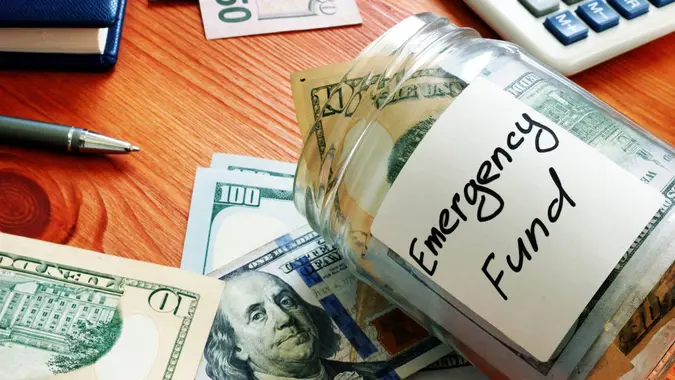How To Save Money: 12 Proven Ways To Keep More Cash

Commitment to Our Readers
GOBankingRates' editorial team is committed to bringing you unbiased reviews and information. We use data-driven methodologies to evaluate financial products and services - our reviews and ratings are not influenced by advertisers. You can read more about our editorial guidelines and our products and services review methodology.

20 Years
Helping You Live Richer

Reviewed
by Experts

Trusted by
Millions of Readers
Learning how to save money can seem tough — especially when it feels like there’s nothing left in your budget to trim. But you don’t have to make huge sacrifices to build your savings. These 12 simple, beginner-friendly tips can help you start saving money today.
Budget-Friendly Shopping Habits
These simple adjustments are great starting points if you’re figuring out how to save money on everyday essentials.
Make a Grocery List and Stick To It
If you constantly throw away food, you’re throwing money in the trash. To prevent this, create a grocery list, and a meal plan.
- Start by planning your meals for the week or your entire pay period and make sure to pack your lunches for work.
- Once you have your meals planned, make a shopping list that includes all of your ingredients.
- Doing so will help you make sure you don’t buy too much, but you have what you need for the meals you intend to cook.
Pro Tip
The outer edge of grocery stores is where you’ll find fresh ingredients like produce, meat and dairy. Sticking to these areas helps you avoid overpriced pre-packaged meals — saving you money and often improving your diet in the process.
Buy Store Brands
Store brands may not have the most appealing labels, but the products are similar to — if not exactly the same as — popular brands. For example, you’ll find that off-brand medications have the same active ingredients as on-brand medications.
Switching to the store brand for medications and other products can add some change to your piggy bank.
Eat at Home To Avoid Restaurant Spending
It is common knowledge that eating out can be more expensive than cooking at home. Cutting back on restaurant spending can go a long way to pad your monthly budget, leaving you wiggle room to put those extra funds away for a rainy day.
Smart Spending Adjustments
Small changes in daily habits can lead to big savings over time.
Cut Unnecessary Spending
The average person pays about $74 per month for cable services. If you got the basic packages at Hulu, Netflix, Disney Plus and HBO Max, you’d pay a total of $38 per month. Switching to those streaming services instead is a savings of $36 per month.
What other unnecessary spending could you cut out of your budget and turn into savings?
Monthly Expense Audit Checklist
Use this list to find out where your money is going — and where you can start saving:
- Review your bank and credit card statements for the last 30 days.
- Highlight recurring charges like subscriptions or memberships.
- Cancel services you rarely or never use.
- Note categories where you consistently overspend.
- Set a realistic budget for variable expenses like groceries.
- Track your spending weekly to stay on track.
Follow the 30-Day Rule
The 30-day rule was designed to help you and others avoid costly impulse buys.
The rule is simple, when you see something new you want, wait 30 days to buy it. If you still want it after 30 days, go for it.
It will likely surprise you how many items you’ll forgo if you give yourself 30 days to think about them.
Debt and Utility Management
Managing debt and trimming utility costs are key to long-term savings.
Transfer Credit Card Balances
High-interest debt from credit cards gets expensive quickly. If you have good credit, you don’t have to pay interest at those high rates.
Here are some points to keep in mind:
- Consider signing up for a zero-interest balance transfer credit card.
- This could cut interest expenses for up to 21 months, saving you hundreds or thousands of dollars in the process.
- Once your credit card debt is more under control you can focus on better options for your charging habits.
- Look into cash-back or rewards credit cards to get more for your buck.
Cut Utility Expenses
The simple act of turning off your lights when you’re not using them can add meaningful dollars to your savings over the course of a year.
You could add to this savings by turning your thermostat up or down one degree. Consider turning it all the way off when you’re at work.
Pay Down Your Debt
Paying off your debt, whether it is student loans or credit cards, is one of the best ways to help your money start going in the right direction again.
Not only can paying your bills on time and in full lower the interest rates you pay but it can also help improve your credit score. This can lead to better rates and savings on future loans.
Refinance Your Mortgage
Do you have a high mortgage payment? You may have purchased your home at a time when interest rates were high. Even if you didn’t, your beginning balance is a determining factor in your mortgage payment amount.
Refinancing may result in a lower interest rate. If you’ve paid off a significant portion of your home, you may end up with lower payments even if your interest rate doesn’t fall.
Money-Saving Tools and Apps
From budgeting apps to automatic transfers, these tools take the guesswork out of managing your finances.
Use a Budgeting App
Let’s face it: some people just haven’t learned how to budget, and that’s OK. Budgeting isn’t something they teach in grade school.
If you have a hard time finding money for savings, consider using a budgeting app like Goodbudget or EveryDollar to take control of your money.
Automate Your Savings
Transferring money out of your paycheck automatically makes it easier to not spend it. Here are a few tips:
- Start a separate savings account to directly deposit a percentage of your paycheck automatically so it’s out of sight, out of mind.
- Where you save your money matters so try and find a high-yield savings account or money market account with a competitive interest rate.
- Your bill paying can also be automated which helps keep your necessary spending accounted for and your discretionary spending in check.
Follow the 50/30/20 Rule
Wondering what the 50/30/20 rule is and if it can work for you? The premise is simple.
- Use 50% of your income for necessities.
- Use 30% for wants.
- Use 20% for savings.
Although you may need to make some lifestyle changes to stick to this, it’s well worth the effort in the long run.
How To Save Money Based on Your Goals
Staying motivated to save more and spend less can come down just to the accountability of setting goals so you can achieve them.
- Saving for emergencies? Start with an automatic transfer of $20 per week into a separate savings account.
- Saving for a home? Set aside at least 10% of each paycheck and keep it in a high-yield account or CD.
- Saving for retirement? Contribute to a 401(k) account or IRA consistently.
Final Take
Try starting with just one small change this week. Maybe that’s canceling a subscription you forgot about or cooking an extra dinner at home. Every step — even the small ones — moves you closer to stronger savings habits.
FAQ
Here are the answers to some of the most frequently asked questions about how to save money.- How can I save $1,000 fast?
- Here are some of the best ways to save $1,000 fast:
- Make a grocery list and stick to it
- Eat at home to avoid restaurant spending
- Buy store brands
- Find ways to cut unnecessary spending
- Transfer credit card balances
- Shop the perimeter of the grocery store
- Follow the 30-day rule
- Refinance your mortgage
- Use a budgeting app
- Cut utility expenses and energy consumption
- Automate your savings
- Build a budget and break it into percentages
- Audit your expenses
- Pay down your debt
- Set savings goals
- Here are some of the best ways to save $1,000 fast:
- What is the 30-day rule to save money?
- The 30-day rule is when you see something new you want you wait 30 days to buy it. If you still want it after 30 days, you should make the purchase but the impulse may have passed. It's a good way to distinguish between what you truly want to buy and what is a passing temptation.
- How do I start saving with no extra income?
- Begin by reviewing your spending. Even trimming $5 or $10 a week -- like skipping one coffee or packing a lunch -- can free up money to start a savings habit.
- What's the best savings account?
- Look for a high-yield savings account with no monthly fees, FDIC insurance and an easy-to-use mobile app. The higher the APY, the faster your savings can grow.
- Can I save money and still enjoy life?
- Yes, saving money doesn't mean missing out -- it just means making smarter choices. Small swaps and better planning let you enjoy life while padding your savings account.
Vance Cariaga and Joshua Rodriguez contributed to the reporting for this article.
Our in-house research team and on-site financial experts work together to create content that’s accurate, impartial, and up to date. We fact-check every single statistic, quote and fact using trusted primary resources to make sure the information we provide is correct. You can learn more about GOBankingRates’ processes and standards in our editorial policy.
- Experian. 2020. "Will Refinancing Home, Auto or Student Loans Save You Money?"
- CNBC. 2022. "We talked to 2 financial planners, and they agree people don’t save enough in these 2 categories."
- Mr. Electric. "How Much Money Can You Save by Turning Off the Lights?"
- Citizens Bank. "What is the 50/30/20 Budget Rule?"
- The Balance. 2022. "What Is a Budget App?"
- CNET. 2023. "Is Streaming Actually Cheaper Than Cable? We Do the Math."
- Feeding America. "Food Waste and Food Rescue."
- CNET. 2024. "Streaming vs. Cable: Which One Saves You More Money?"
 Written by
Written by  Edited by
Edited by 

























